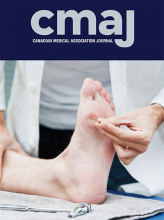A 31-year-old man with a history of allergic rhinitis, asthma and eczema presented to the emergency department with sudden dysphagia and food impaction while eating steak. He reported intermittent dysphagia and gastroesophageal reflux over several months despite proton pump inhibitor therapy. We diagnosed “steakhouse syndrome,” or esophageal food impaction. The gastroenterology team performed urgent esophagogastroduodenoscopy, which showed furrowing and concentric rings, consistent with eosinophilic esophagitis (Figure 1A).1 They extracted the impacted food endoscopically (Figure 1B). Esophageal biopsy showed eosinophilic esophagitis. We prescribed pantoprazole 40 mg twice daily and fluticasone propionate 440 μg twice daily (swallowed, not inhaled). He has since required periodic dilatation of strictures.
Esophagogastroduodenoscopy images from a 31-year-old man with acute food impaction, showing (A) concentric ring formation or felinization (white arrows), a typical finding of eosinophil esophagitis, and (B) an impacted piece of steak (black arrow) at 30 cm.
Food impaction in the esophagus occurs in 25 people per 100 000 per year.2 Beef, chicken, pork, poorly cooked vegetables and rice have been most frequently incriminated. Eosinophilic esophagitis is a common cause of food impaction seen in the emergency department; others are esophageal stenosis, malignant disease, hiatal hernia and dysmotility.2 Strictures develop in 17%–70% of patients, depending on delays in diagnosis. Esophageal dysmotility and fibrostenosis cause food bolus obstruction, which, if left untreated, can lead to dehydration, pulmonary aspiration and esophageal perforation within 24 hours.3
Esophageal eosinophilia (≥ 15 eosinophils per high power field) and exclusion of other potential causes of tissue eosinophilia (proton pump inhibitor therapy, Crohn disease, malignant disease, autoimmunity, drug hypersensitivity and parasitic disease) and endoscopy help confirm eosinophilic esophagitis.4 Patients are asked to swallow (not inhale) fluticasone (440–880 μg twice daily), avoiding food or drink for 30 minutes afterward.5 Budesonide for nebulizer use can be administered as a slurry mixed with a flavoured sugar substitute (off-label use). Dupilumab, an antibody to interleukin-4, has recently received approval from the United States Food and Drug Administration for patients with refractory eosinophilic esophagitis, but its use is limited by availability and cost. Impacted food may require endoscopic extraction, while strictures may require dilatation.
Footnotes
Competing interests: Guha Krishnaswamy reports royalties from UpToDate and a previous role as an external consultant for Johns Hopkins University. No other competing interests were declared.
This article has been peer reviewed.
The authors have obtained patient consent.
This is an Open Access article distributed in accordance with the terms of the Creative Commons Attribution (CC BY-NC-ND 4.0) licence, which permits use, distribution and reproduction in any medium, provided that the original publication is properly cited, the use is noncommercial (i.e., research or educational use), and no modifications or adaptations are made. See: https://creativecommons.org/licenses/by-nc-nd/4.0/












